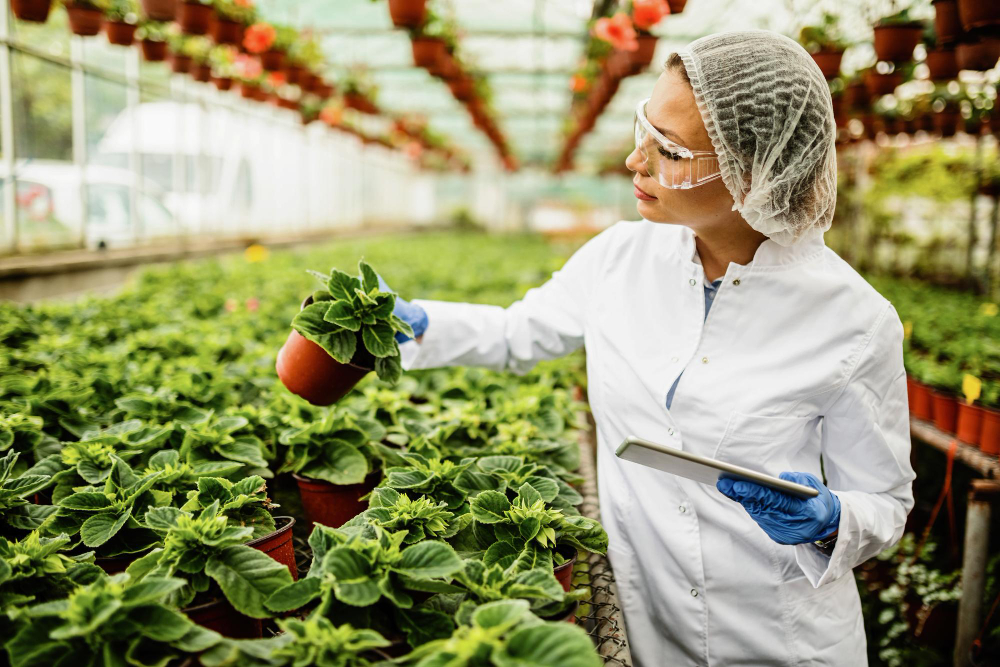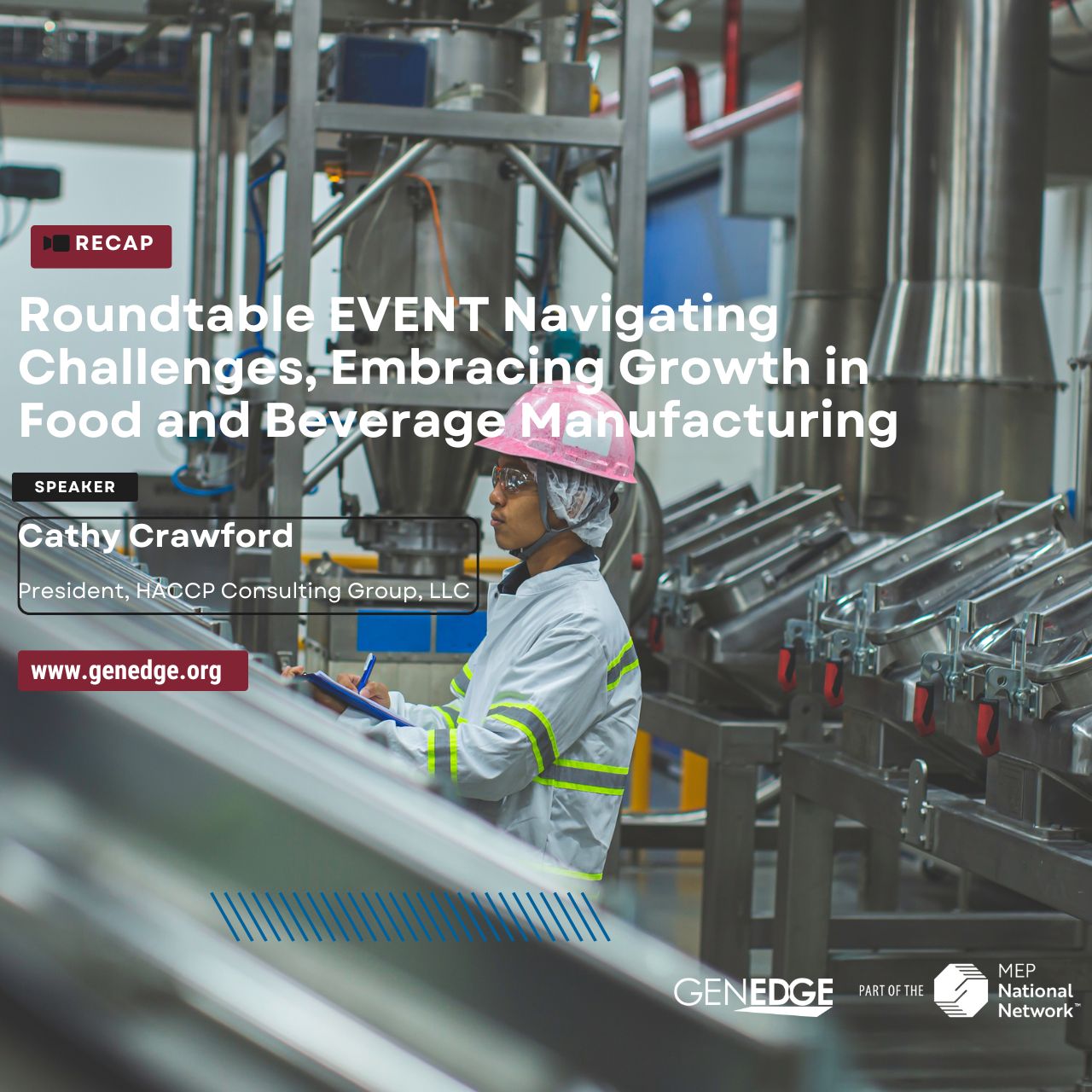The food supply chain follows the entire journey of food products, from their initial production stages to consumption. It ensures that the food we eat and the products we manufacture are safe, traceable, and high-quality.
However, many Virginia manufacturers take the logistics that go into the process at face value. This blog uncovers the ins and outs of the food and beverage supply chain, common problems you may face, and how to solve them with the help of food production consultants.
LISTEN TO OUR MANUFACTURING PODCAST: Manufacturing NOW
Table of Contents
- What is a food and beverage supply chain?
- How a food and bev supply chain works
- Common challenges and how to solve them
- 5 ways to streamline your supply chain
- A recap of GENEDGE’s Virtual Roundtable Discussion

What is a food and beverage supply chain?
The food and beverage supply chain is basically the journey your food takes to reach the consumer. It starts at the farm or factory and ends up on your plate, covering things like manufacturing, managing, using, and eliminating food. This process involves raw materials, packing, and distribution.
Watch the Recap: Food & Beverage Roundtable Discussion
Some foods go straight from the farm to packaging, while others need more processing first. Ultimately, everything gets to the customer, so keeping this system running smoothly through process optimization is key. Each part of the chain depends on the others, all working together to ensure your product is safe and on time, no matter where it’s headed.
How does it work?
Think about your favorite snacks and drinks—yogurt, fresh greens, coffee, or soda. Each of these goes through a delicate journey before it reaches you. Here’s a simplified look at the five basic steps they usually pass through:
- Production: Foods and drinks start at the source—farms or production facilities.
- Processing: Some items, like coffee beans or soda, require additional processing to transform raw materials into consumable products.
- Packaging: After processing, products are packaged to ensure quality, safety, and convenience for transport.
- Distribution: Packaged items are then shipped to various locations, like grocery stores or warehouses, using reliable transport networks.
- Retail: Finally, once the products reach retailers, they become available for purchase and ready to be enjoyed.
Common challenges with the food and bev supply chain and how to solve them
Perishability
Many food products are perishable, requiring refrigeration and quick transportation solutions. Implementing a highly optimized cold chain helps preserve product quality from production to consumption. Companies must invest in advanced cold chain management technologies to handle the delicate balance of temperature control and delivery speed.
Unpredictable consumer preferences
Consumer tastes can change rapidly, influencing demand and inventory levels. To stay ahead of these fluctuations, businesses should utilize data analytics to predict trends and adjust their operations accordingly. Real-time consumer feedback and market analysis can aid in refining product offerings and maintaining consumer satisfaction.
Regulatory standards
Strict food safety and quality regulations are constant in the industry. To meet these standards, companies must establish comprehensive compliance programs and regularly update employee training. Investing in traceability systems can also help ensure transparency and accountability throughout the supply chain, reducing non-compliance risk.

5 ways to streamline your food and bev supply chain
Here are some actionable strategies that food and beverage manufacturers like you can adopt to improve your supply chain efficiency:
1. Collaboration and culmination of trust
Building relationships with reliable partners can create a network of trust and transparency essential for adapting to market shifts. For example, cooperative strategies enable Virginia manufacturers to diversify their source base, ensuring flexibility and resilience in disruptions.
2. Technological integration
Leveraging technology is everything. Real-time tracking, AI-driven demand forecasting, and predictive maintenance solutions can improve supply chain operations. By adopting these technologies, businesses can anticipate challenges before they escalate, keeping the supply chain agile and responsive.
3. Sustainability initiatives
Reducing waste and promoting eco-friendly practices can profoundly impact the bottom line and the environment. Embracing sustainable packaging and efficient transportation strategies minimizes waste, aligning operations with global efforts toward sustainability.
4. Rigorous temperature controls
Maintaining specific temperature conditions is crucial in preventing spoilage. Organizations can use sophisticated telematics systems to monitor conditions accurately, ensuring that perishable products remain safe and wholesome throughout the supply chain.
5. Fast and safe deliveries
Strategies such as route optimization and workforce training are vital in reducing delays and safeguarding product integrity. Ensuring efficient delivery practices helps maintain freshness and meet the demands of consumers.
Recap: GENEDGE Virtual Roundtable Discussion
GENEDGE’s food production consultants can aid food and beverage manufacturers by providing comprehensive consulting services tailored to tackle industry challenges such as cost reduction, food safety compliance, quality control, and labor shortages.
Through its offerings, including food safety training on HACCP, SQF, and PCQI and insights into Lean Industry 4.0 smart manufacturing, GENEDGE’s supply chain optimization consultants equip Virginia manufacturers with the tools needed to continuously improve their supply chain.
In the recent GENEDGE Virtual Roundtable, Kathy Crawford from Hassett Consulting Group opened the session by outlining her vast experience in the food safety domain, emphasizing her passion for assisting small and medium-sized companies in navigating the complexities of food safety regulations. “I’ve worked for a wide variety of foods and discovered that most food companies when they’re small or medium, struggle with understanding food safety systems,” Kathy candidly shared, highlighting the need for comprehensive education.
Blanca Ruiz, also from the Consulting Group, echoed this sentiment, drawing upon her 22-year background in safety and quality assurance within the consumer packaged goods industry. Together, they delved into key topics, such as the distinctions between USDA and FDA regulations and the intricacies of forming a supply chain-friendly, compliant HACCP plan—a frequent area of inquiry from companies seeking guidance.
Crawford noted, “A HACCP plan is crucial as it helps companies map out risks and establish necessary controls across their operations to ensure consumer safety.” Furthermore, discussions on regulatory requirements revealed that understanding whether a business falls under USDA or FDA jurisdiction is vital, as this dictates the necessary compliance and inspection protocols.
This session dissected the legislative framework and provided strategic insights into incorporating safe practices and control mechanisms. GENEDGE aims to be a valuable resource and partner for manufacturers, offering consulting services to enhance compliance and competitiveness in the food sector.
For more, click here to get answers, get support, and get rolling!


